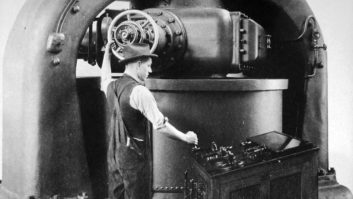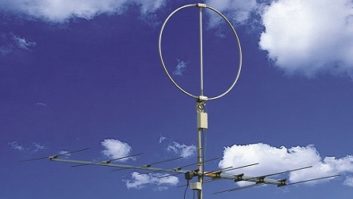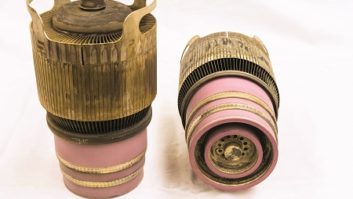Maximum Burn
Apr 1, 2004 12:00 PM, By Alex Kosiorek
The Compact Disc Recordable (CD-R) remains the most common optical media format used in audio/radio production environments. Ever since the CD-R became common as a storage medium for digital audio and data, questions and opinions have addressed which brands and types of CD-R are best, the optimum speed to burn a disc, as well as appropriate ways to label and care for the disc. These concerns are actually increasing as optical media evolves along with the plethora of drives available in the marketplace.
For some, this subject may seem a little mundane. You may have used one type of optical media for ages and haven’t had a problem. Or you plan to purchase the least expensive media available, unaware of the variables of optical media. Up until a year ago, I consistently used the same brand media and burned at the same speed without a hitch. I based my choices on research published a few years prior, tempered by personal experience. Then, I encountered problems that I hadn’t seen before and was stuck with a hundred-plus CD-Rs with audible errors when played on consumer players. After some research, I found that the composition of the CD-R I was accustomed to had been altered.
With the increasing number of optical formats, faster drives and combination drives on the market, the demand for higher speed media has risen, and media manufacturers have produced optical media to accommodate, making it crucial to monitor the optical media stock you purchase for valued audio productions and archival usage � even if you haven’t changed brands.
Faster, faster
With higher speed media, manufacturers have changed the data-recording layer of a CD-R. The data layer of a CD-R is different from that of commercially released pressed/molded CDs and CD-RWs in respects to their composition. A standard CD has a read-only data layer made up of a molded aluminum substrate. CD-RWs data-recording layer is made up of a rewritable phase changing metal alloy. With the CD-R, this layer is made up of an organic photosensitive dye, which can be changed only once by the writing laser of a compact disc recorder. This organic dye will degrade over a long period of time. This degradation can be accelerated considerably by improper care and storage � eventually making the disc unusable.
This raises the question: What is the best way to determine the best disc for a specific application? First, one of the main variables that comes into play is the type of CD-R recorder being used. There are basically two types of drives: stand-alone CD recorders that record in real time (1�) and internal/external computer drives that burn at multiple speeds. Choose wisely when purchasing CD-R media and ensure that the media type is formulated specifically for that drive type.
Recordable discs used in a stand-alone recorder should be formulated specifically for slower burn speeds. A disc that is labeled high speed compatible or 1� to 48� is highly unlikely to be formulated for slow burn speeds. Many users of stand-alone audio CD recorders have problems when using media formulated for speed ratings in excess of 24� or 32�. Even if the higher speed-rated disc records and finalizes appropriately in the stand-alone CD recorder, considerable amounts of errors may exist on these discs such that they are unplayable in certain players or the playability may deteriorate over time.
Also, because stand-alone recorders use lower-powered lasers than that of multi-speed computer counterparts, using higher speed-rated discs strain these units, which can reduce component life. Where does one find these lower speed discs? Various manufacturers have them available, many labeling them as music CD-R or audio CD-R. Verbatim produces them under these names as well as Digital Vinyl. Be careful, however, because some of these discs have high-speed ratings. It will take a little investigation to find the lower-speed discs, but a general rule of thumb is: the lower the speed rating the better, and if you see a speed rating higher than 32�, the discs are not formulated for slower speeds.
With computer drives that burn at variable speeds, especially new drives that can burn as fast as 52�, determining the best disc and burn speed becomes more difficult. With all the different types of discs available, there isn’t a specific speed that will always produce the best result. Results will vary from one drive model to another, with different media, and in some cases even with different drive firmware. There are several dedicated test tools that evaluate media performance, made by companies such as Clover Systems and Stagetech, easily costing $5,000 or more. However, there are affordable and practical methods that can help.
Careful evaluation
The first step in evaluating media for a particular high-speed CD recorder, is to read the manual or manufacturer’s website to see if specific brands of media are recommended. Ideally, in those cases, the manufacturer has tested the media and tuned the unit for satisfactory results. Be careful, however, of who the manufacturers, or anyone else for that matter, suggests. Most of the media commonly found in big box consumer stores are made by a wide variety of other media manufacturers. Fuji, Imation, Maxell, Memorex, Sony and TDK are several that do not make their own optical media. Those brands are made by CMC Magnetics, MAM-A (formerly Mitsui), Prodisc, Ritek, Taiyo Yuden and lesser-known manufacturers. Even though another manufacturer makes the media, it may not be made to the same tolerances as if it were branded with their own name on the package. In several cases, especially with generic discs, the lowest bidder will create the media, thus the actual manufacturer and quality can change without notice. To determine who makes the media you are using, download a CD identifier or CD info application, which can be found and downloaded through a Web search. A CD identifier will tell you the manufacturer of the disc, as well as organic dye configuration, and other information. Again, buyer beware, some lesser-known media manufacturers can produce a disc that can fool a CD Identifier to indicate that it is made by a major manufacturer.
If you purchase the media recommended by the optical drive manufacturer, and burn at or below one-third of the drive’s maximum rated burn speed (i.e. 4� to 16� in a 48�-rated drive), your chances for having problems will be low. For valuable audio productions, use name-brand media from manufacturers that make their own media. Key manufacturers of media include MAM-A, Ritek, SKC, Taiyo Yuden, and Verbatim Data Life Plus (Mitsubishi Chemical). Stay away from generic discs or those that are store-name branded. This is especially true for critical applications.
To determine the best media and burn speeds further, there are some basic tests you can perform. To do so, buy small quantities of quality name brand media. Take the small quantity of CD-Rs you bought and record onto them at different burn speeds (using increments of 4� if possible) with the software and hardware you commonly use, producing playable audio discs. When burning the discs, ensure that the only variable changing is the burn speed. This may be difficult to specify, depending on your application. Easy CD Creator, for example, allows you to select a specific burn speed, but in many cases, you will see the burn speed fluctuate as you increase the requested burn speed. Use the same files and software version for each test. Also, use lengthy audio files that will consume the majority of the CD-R’s capacity.
Also note that when producing these discs, it is important that you create playable audio, not data discs, for two reasons. First, audio discs use a different type of error correction than data discs. Second, audio discs are the main type used in our production environments.
Critical efforts
Whenever you are testing or making a critical CD-R (especially one for archival storage or for replication), burn the discs in disc-at-once mode instead of track-at-once mode method, which is available in many audio and duplication applications. Disc-at-once mode will burn the disc in its entirety without switching the writing laser off. Track-at-once will burn each track separately; switching the write laser on and off. Track-at-once produces errors on the disc, often rectified on playback via error correction. In addition, track-at-once discs do not conform to the Red Book specifications (the standard for audio CDs), thus making them incompatible with various players and not excepted by various duplication facilities.
Another thing to avoid is creating errors when labeling a disc. Do not use a ballpoint pen or an alcohol-based pen. Because the data-recording layer of a CD-R is located close to the top (label side) of the disc, ballpoint pens can scratch and damage that data layer. Alcohol based pens can dissolve the disc coating, causing data loss. Use a water-soluble ink pen instead. Several media distributors have CD marking pens available. Other precautions include keeping media away from sunlight/ultraviolet light, heat and moisture.
There are several applications that can assist when testing discs. The most thorough program, allowing for evaluation of media, is Plextools Professional by Plextor (www.plextor.com). Its one drawback is that the testing functions of this program only work with Plextor’s Plexwriter Premium drive and with its upcoming DVD+/-RW/CD-RW drive model PX-712A. Note that the Plexwriter Premium drive is affordable and highly rated among audio recording and mastering engineers, Nero/Ahead Software and others. Some other useful tools include those listed below.
Among Plextools Professional test functions are those that check for C1 (or sometimes referred to as BLER), C2 and CU errors, along with jitter and beta tests (checking the symmetry of the pits and lands of a disc). C1 errors are commonly found on a disc. However, high amounts of these errors can create uncorrectable errors when the discs’ playability decreases. The same holds true for C2 errors, however, these along with CU errors (which are more critical) shouldn’t exist on a newly burned disc. CD Speed also checks for C1 and C2 errors, but only if the drive supports these test functions. The other useful feature from Plextools is the jitter and beta tests. Jitter and beta allow fine tuning to find which burn speeds are best for the media and drive.
I performed these tests using recommended media on a wide variety of computers/drives in our production studios and at home. A greater amount of errors occurred on older drives and inexpensive OEM drives. When using recommended media on newer drives, C1 errors were low and all other errors nonexistent. It was the jitter and beta tests that were most revealing. A lower jitter level (seen in blue) and consistent unwavering beta level (in red) are preferred. For instance, test results show that the best jitter and beta levels using Vertabtim Data Life Plus 4� 74-minute Inkjet Printable Media, burned using Nero 6, in a Plextor PX-708A, in our particular computer configuration is at 8� and 16�. I have observed higher jitter or wavering beta levels at other burn speeds.
Notice the same media used in Rimage Amigo II duplicator produces poor results in this test. These discs produced audible errors when played in certain consumer players.
Another useful, simple test available on Plextools, CD Speed and Exact Audio Copy is the ability to perform a Digital Audio Extraction (DAE) with a basic error report. DAE is a process of extracting the audio from a disc and then saving that audio onto a computer’s hard drive in various formats (WAV, MP3). Each program checks, reports and can correct errors while extracting the audio in a slightly different fashion. However, a general rule of thumb is that a DAE of a newly-created disc should report no errors. Users should perform these tests on more than one computer/drive, or at least perform the tests on a different optical drive from the one that the disc was originally created on.
The last of the mentioned programs, CD/DVD Diagnostic offers a unique method to check for errors. It performs what the program calls a readability test. During this test, the program basically disables many of the data recovering methods normally used by the reading drive. It then reports on what is called soft and hard errors. Soft errors are those that the reading drive normally would correct without informing the computer. Hard errors are those that may be recovered from if additional reads of the disc are made. CD/DVD Diagnostic and its more expensive counterpart CD/DVD Inspector provide a statistical model of the tests performed to determine if a disc is good or bad. Following the instructions of the program, I found on that newly created discs burned at speeds between 4� and 16� produced little or no errors whatsoever. Soft errors did occur with a discs burned at 32� and above on certain burners, indicating that faster burn speeds produce read errors in various drives. Also, the Rimage-created disc noted previously as having higher jitter levels also produced higher amounts of soft errors using this program.
Because of the multitude of variables with CD-R media, drives and ancillary components, the complexity of determining the best media and drive combinations increases. Performing these tests can be an educational experience. The optical media arena is changing and expanding. How-ever, there are some basic affordable test tools now available to help maintain this equation. Overall, the following guidelines will produce the best results:
- Purchase media formulated for your drive and application.
- Use higher rated drives.
- Be cognizant of how the discs are created.
- Burn discs using the lower 1/3 of the drives writing ability.
- Label and care for your discs appropriately.
By taking these measures, your CD-R masters should last a considerable length of time and be able to be read by a wide variety of players.
Kosiorek is the audio recording and mastering engineer at the Corbett Studio at WGUC-FM, Cincinnati.
Useful tools
- CD Speed, an application from Nero/Ahead Software is a free download www.cdspeed2000.com
- CD/DVD Diagnostic from Infinadyne www.infinadyne.com
- Exact Audio Copy www.exactaudiocopy.de








